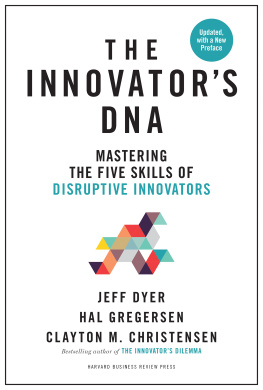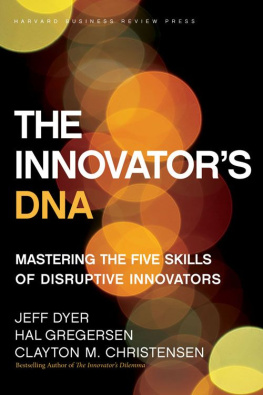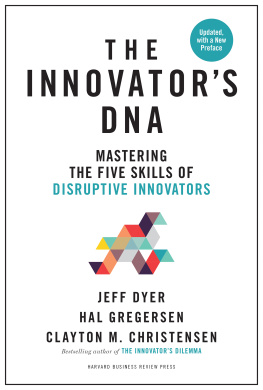Table of Contents
List of tables
- Chapter 1
- Chapter 2
- Chapter 3
- Chapter 4
- Chapter 5
- Chapter 6
- Chapter 7
- Chapter 8
List of figures
- Chapter 1
- Chapter 2
- Chapter 3
- Chapter 4
- Chapter 5
- Chapter 8
Guide
Pioneers, Hidden Champions, Changemakers, and Underdogs
Lessons from Chinas Innovators
Mark J. Greeven, George S. Yip, and Wei Wei
The MIT Press
Cambridge, Massachusetts
London, England
2019 Mark J. Greeven, George S. Yip, Wei Wei
All rights reserved. No part of this book may be reproduced in any form by any electronic or mechanical means (including photocopying, recording, or information storage and retrieval) without permission in writing from the publisher.
This book was set in Sabon by Toppan Best-set Premedia Limited. Printed and bound in the United States of America.
Library of Congress Cataloging-in-Publication Data
Names: Greeven, Mark J., author. | Yip, George S., author.
Title: Pioneers, hidden champions, changemakers, and underdogs : lessons
from Chinas innovators / Mark J. Greeven, George S. Yip, and Wei Wei.
Description: Cambridge, MA : MIT Press, [2019] | Includes bibliographical
references and index.
Identifiers: LCCN 2018030556 | ISBN 9780262039697 (hardcover : alk. paper)
eISBN 9780262352321
Subjects: LCSH: Technological innovations--Economic aspects--China. | New
business enterprises--China. | New products--China. |
Entrepreneurship--China.
Classification: LCC HC430.T4 G74 2019 | DDC 338/.0640951--dc23 LC record available at https://lccn.loc.gov/2018030556
ePub Version 1.0
d_r0
Mark J. Greeven dedicates this book to Irene Greeven-de Gruil and Harry Greeven.
George S. Yip dedicates this book to Lucas Yip and Ellie Yip.
Wei Wei dedicates this book to Chen Jingmin.
Acknowledgments
Mark J. Greeven thanks Zhejiang University (ZJU) School of Management, ZJU alumni, and the many Chinese entrepreneurs for enabling most of this research. George S. Yip thanks the Centre on China Innovation (CCI) at China Europe International Business School (CEIBS) and CCIs corporate sponsors (Akzo Nobel, Bosch, DSM, Philips, and Shell) for their previous support of his research about innovation in China and Imperial College Business School for its current support. Wei Wei thanks the alumni of Tsinghua University and the participants of our executive workshops with companies such as Bosch, DSM, Philips, Sanofi, Vanderlande, and others that have provided critical and reflective perspectives on our ideas and helped to develop the key insights from a business and professional perspective.
We thank Emily Taber, editor in economics, finance, and business at the MIT Press, for signing this book and for sharing her insights and encouragement. We also thank the anonymous reviewers who have helped to improve this book. We thank the manuscript editor, Rosemary Winfield, for her meticulous work.
Introduction: Chinas Emerging Innovators
The time is long gone when tech unicorns, digital disruptors, and celebrity entrepreneurs came exclusively from Silicon Valley. A new generation of Chinese entrepreneurs includes the many elite entrepreneurs who return from overseas studies and establish technology ventures as well as young digital natives who are disrupting the world of industry incumbents, creating hero entrepreneur identities, and relentlessly pursuing growth. In addition, hundreds of global market leaders from China appear to be hidden from the broader global publics view. This book is about the rise of these emerging Chinese innovators.
What Is This Book About?
This book is about who is innovating in China and how they are doing it. Although corporate professionals and academic observers have praised the innovators behind companies such as Alibaba, Haier, and Huawei, there is more to come. Dozens if not hundreds of hidden champions (a term first used by Hermann Simon to describe small and medium-sized enterprises that are highly successful but inconspicuous) already occupy global leadership positions in various industrial niches, and an enormous number of Chinese innovators are operating under the radar. Moreover, a new generation of changemakers in China is looking beyond boundaries and cultivating a disruptive business mind set. If one Alibaba can shock international stock markets and disrupt traditional industries, we can only imagine what tens of thousands under-the-radar technology entrepreneurs, global hidden champions, and young changemakers will accomplish. This book is about Chinese innovatorsnot only the large domestic incumbents but those next-generation changemakers who are operating under the radar.
We take a strategic perspective and focus on managerial questions to explore the opportunities and challenges that Chinese innovators pose for Chinese and global markets. This is a remarkable opportunity for small and large companies inside and outside of China. Business observers have announced that we live in turbulent, hypercompetitive, and uncertain times, but Chinese innovators have never known otherwise. They have proven to be well equipped to deal with and embrace widespread technological, market, and regulatory uncertainties to better their competitive positions.
This book is organized around the why, who, what, how, and whats next questions about innovation in China. The why question asks what makes innovation in China a long-term necessity. The remainder of chapter 1 outlines the drivers of innovation, including encouragement by the government, increases in the cost of labor, intensifying competition, and the rise of a demanding middle class. We briefly review the key conditions that are facilitating and inhibiting innovation in China, such as manufacturing capability, venture capital, standardization, the management and protection of intellectual property, and innovation islands.
In chapters 2 to 5, in a search for an answer to the question of who is innovating in China, we go beyond the traditional business-school emphasis on large successful companies, which typically are domestic market leaders and global companies. We also do not focus exclusively on what economists call small businesses, a term that usually refers to the small ventures that are run by mom-and-pop entrepreneurs and are drivers of any economy. The book also does not focus only on student or nascent entrepreneurs or born-global companies (companies that from inception use resources from and sell products in many countries). The purpose of the book is to identify and assess all types of entrepreneurial innovators, regardless of size and visibility. Drawing on our decade-long in-depth study and the extant innovation literature, we define innovators as companies that successfully develop and commercialize new offerings that bring new value to customers. New offerings may include new products and services, new business processes, new business models, new ways to organize the value chain, or new organizational arrangements. The key is that innovation brings new value to customers (whether they are existing or new customers or are consumer, business, or government customers) and that the innovation might be new to the world, new to the industry, or new to the country and region.
We distinguish four types of innovators in China (pioneer, hidden champion, underdog and changemaker) according to two dimensions (mass market and niche market) (). We distinguish incumbent innovators from newcomers, and we distinguish mass markets from niche markets.









